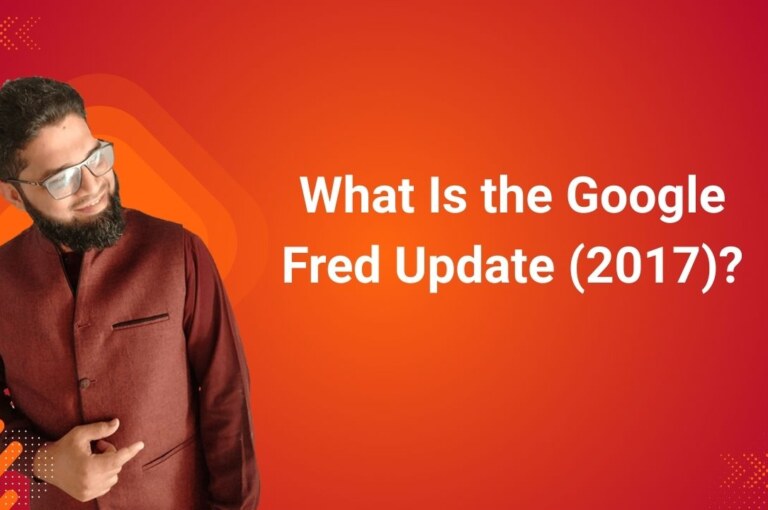What Is the Google Fred Update (2017)?
The Google Fred Algorithm Update, rolled out in March 2017, was a significant algorithm change aimed at targeting low-quality content and websites that violated Google’s Webmaster Guidelines. Although the update was named humorously by Google’s Gary Illyes (who referred to it as “Fred”), it brought serious consequences for many websites. Fred specifically focused on penalizing sites that prioritized monetization over user experience, ultimately improving the overall quality of search results.
What Was the Purpose of the Google Fred Update?
The primary goal of the Fred update was to enhance the quality of search results by targeting websites that:
Prioritized monetization (e.g., excessive ads) over providing real value to users.
Published thin, low-value content, often loaded with affiliate links or poorly written material.
Violated Google’s Webmaster Guidelines, particularly those related to content quality and user experience.
By penalizing sites focused on profit rather than user engagement and value, Google aimed to:
Reward high-quality websites that provided relevant, meaningful content.
Improve user experience and search result quality.
Push businesses to prioritize valuable content rather than relying on ad-heavy pages or spammy practices.
How Did the Fred Update Impact Websites?
The Fred update caused significant changes in the rankings of many websites, especially those with:
Affiliate marketing content.
Content farms.
Over-monetized websites with excessive ads.
Low-quality blogs with minimal original content.
Websites affected by Fred experienced:
A drop in organic search rankings.
Reduced traffic from Google Search.
Loss of ad revenue due to decreased visibility in search results.
What Types of Websites Were Targeted by Fred?
The Fred update was particularly harsh on websites that displayed the following characteristics:
1. Excessive Ads:
Sites with intrusive or excessive ads, especially those placed above the fold, were hit hardest.
2. Thin Content:
Websites with minimal, low-value content filled with affiliate links and little substantial information.
3. Low-Quality Backlinks:
Websites relying on spammy or irrelevant backlinks for ranking purposes.
4. Over-Monetization:
Sites focused primarily on monetizing through ads at the expense of providing genuine value to users.
How Did Google Identify Sites to Penalize?
Google used a combination of algorithmic signals and manual reviews to identify websites violating their guidelines. Factors that Google considered included:
Bounce rate and time on site (indicators of low-quality content).
Page load speed and mobile-friendliness.
The ratio of ads compared to the actual content.
The relevance and quality of backlinks to the site.
How Could Websites Recover from the Fred Update?
Websites hit by the Fred update could recover by addressing the following areas:
1. Create Original, Valuable Content:
Focus on providing in-depth, informative content that meets user intent and adds value.
2. Limit Ads:
Reduce the number of ads and avoid placing them above the fold or in a way that disrupts the user experience.
3. Optimize Website Performance:
Improve site speed, ensure mobile-friendliness, and enhance site structure to improve overall user experience.
4. Disavow Spammy Backlinks:
Remove or disavow irrelevant or spammy backlinks that are hurting your site’s reputation.
5. Prioritize User Experience:
Shift focus from monetization to creating user-centric content that fosters engagement and trust.
What Were the Long-Term Implications of the Fred Update?
The Fred update sent a strong message about the importance of quality content and user experience in SEO. The key takeaways were:
Google’s commitment to rewarding high-quality, user-friendly websites.
A shift towards content and design strategies that prioritize value over quick profit.
Over-monetization and thin content became more of a risk to rankings.
The Fred update set a new precedent for future algorithm changes, emphasizing the need for websites to focus on genuine content and user-first design.
How Did the SEO Community React to the Fred Update?
The SEO community had a mix of reactions to the Fred update:
Positive Reactions:
SEO professionals praised Google for targeting low-quality sites, helping improve the overall quality of search results.
Many were in favor of reducing the influence of over-monetized sites that focused only on profits.
Criticisms:
Some argued that smaller websites and affiliate marketers were disproportionately affected by the update, with some high-quality sites getting caught in the penalty net.
There was concern that ad-heavy sites were punished for monetizing, despite providing value.
What Lessons Can Be Learned from the Fred Update?
The Fred update offered several key lessons for website owners and SEO professionals:
Content Quality: High-quality, user-focused content is essential for long-term success.
User Experience: Websites should prioritize usability and accessibility over monetization.
Adherence to Guidelines: Adhering to Google’s Webmaster Guidelines is essential to avoid penalties.
SEO Strategy: Avoid over-relying on monetization or using unethical SEO tactics like link farming or keyword stuffing.
How Does the Fred Update Compare to Other Google Algorithm Updates?
The Fred update can be compared to other major updates like Panda, Penguin, and Hummingbird, but it was unique in its focus on:
Over-monetization and ad-heavy sites.
The intersection of content quality and user experience.
Unlike Panda (which focused on thin content) or Penguin (which targeted spammy backlinks), Fred dealt with ads and content together.
What Is the Legacy of the Google Fred Update?
The Fred update remains one of the most impactful Google updates, with its legacy including:
A stronger emphasis on user experience in SEO strategies.
Increased awareness about the risks of over-monetization.
A reminder that Google’s algorithms reward websites that prioritize users over profits.
You and website owners can focus on building more sustainable, user-friendly online presences that thrive in the evolving SEO landscape, by understanding Fred’s impact.
Final Thoughts on the Google Fred Algorithm Update:
The Fred update represented a critical turning point in SEO, forcing websites to shift their focus from short-term ad revenue to long-term content quality and user satisfaction. This update continues to influence how SEO professionals approach monetization, content creation, and user experience. Understanding its core principles can help websites remain competitive in Google’s search results.
Want to Go Deeper into SEO?
Explore more from my SEO knowledge base:
▪️ SEO & Content Marketing Hub — Learn how content builds authority and visibility
▪️ Search Engine Semantics Hub — A resource on entities, meaning, and search intent
▪️ Join My SEO Academy — Step-by-step guidance for beginners to advanced learners
Whether you’re learning, growing, or scaling, you’ll find everything you need to build real SEO skills.
Feeling stuck with your SEO strategy?
If you’re unclear on next steps, I’m offering a free one-on-one audit session to help and let’s get you moving forward.




